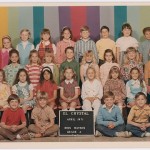Most teachers, including myself, feel that standards are a significant part of the learning process. They help keep our students on track. They help us organize and develop our curriculum and our yearly scope and sequence. Students then take tests with those scores determining to what extent they understood those standards. Those scores are often used to determine how effective a teacher has been with those students (including many other variables). However, there is much more to developing a good human being that will make positive contributions to society than just the standards. To me, priority one involves building relationships with students, while priority two involves creating lessons that not just hit the standards, but will also be meaningful and relevant to the students, with many opportunities for real-world application. When teachers think “outside the box” and teach “beyond the standards,” special things can happen.
Teaching the “whole child” is important to me. Each year, we watch a video of a softball player hitting a home run, but then tearing her ACL while rounding the bases. To ensure her home run would count, two girls from the other team offered to carry her around to touch each base. Every time I show it to my students, most of them start to shed a tear. Then, we have a discussion, providing examples on how we can put others first. That video is something students remember for a long time. When I think of what I am most proud of as a teacher, I think of students making positive contributions beyond physical education. I think of students sharing stories on how they donated food, clothes, or toys to the less fortunate. I think of students being kind and empathetic at recess to those who, at first, might seem or weird or “different.” These are what make me smile and make me feel good about teaching.
Every student, regardless of ability or background, has a need to belong and should always be included, accepted, and respected in class. I believe in a culture of inclusion; a philosophy that helps guide my practice. Character traits like open-mindedness, including others, showing empathy need to be practiced, just like physical skills such as hand-writing or throwing a ball. Luckily, physical education is a perfect opportunity to embed these. In class, I praise characteristics that everyone is capable of doing (being kind, taking turns, and helping others). This helps level the playing field and makes all students feel comfortable, regardless of their perceived athletic ability. These characteristics aren’t necessarily PE “standards.” However, they are relevant, significant skills that will help them be successful in multiple settings and their future. Focusing on and highlighting these helps students feel not only physically safe but also emotionally safe, where they feel comfortable enough to take risks.
When people ask me, “Why did you become a teacher, and specifically, why teach physical education teacher?” For me, and for most PE teachers I know, the word “standard” never comes up. The answer usually has something to do with making a difference in the lives of students. I also think of a quote that states, “Physical Education is the only subject which, by the very nature of its content, has the potential to affect how a person will feel every moment of every day for the rest of his or her life.” That is a huge responsibility that I don’t take lightly. I get to teach them things like how to develop relationships, live a healthy lifestyle, how to reduce stress, and how to build confidence, just to name a few. As someone who teaches every child in the school, I get an opportunity to be that positive, adult role model. Every student deserves that, but not every student has that at home. That goes “beyond the standards.”
Don’t get me wrong, standards are important. They help hold teachers and students accountable throughout the year. They help guide instruction. However, the most special, memorable moments in my classes have been when we went beyond those. They often are emotional and meaningful, while also providing students a different perspective.
I am always looking to improve and learn from others. How do YOU go “beyond the standards” to create memorable moments for your students?










Comments 4
This year teaching beyond the standards for me has looked like teaching students social and emotional skills. As a primary teacher, this is something that we have to do every year anyway, but has been so much more important. Usually teaching these skills looks like how to take turns, share appropriately, use kind words, and while these skills are still things I taught, we had to focus on “how to listen appropriately” and “how to calm down”. After learning online for so long, I think students really struggled to listen and follow through with all of the directions each day. At home, they could just log out of the Google Meet or turn the volume off, but doing that in person is not an option. I hope my students will remember these skills over the summer!
This is an interesting statement – For me, and for most PE teachers I know, the word “standard” never comes up.
I have sat on so many standard committees to help guide the work of teachers. My National Board Standards were so important to me. But you are so right, they do not define our work, they simply support our work. Too often, we lose sight of that.
My goal is always to foster a community of collaboration within my classroom. As young scientists, teamwork and communication are important parts of the scientific process. For those that go on to pursuits outside of science, they will still have developed interpersonal skills that make them successful anywhere.
This is exactly what I needed today! It’s the last day of school and I am beyond tired. This brightened my day!